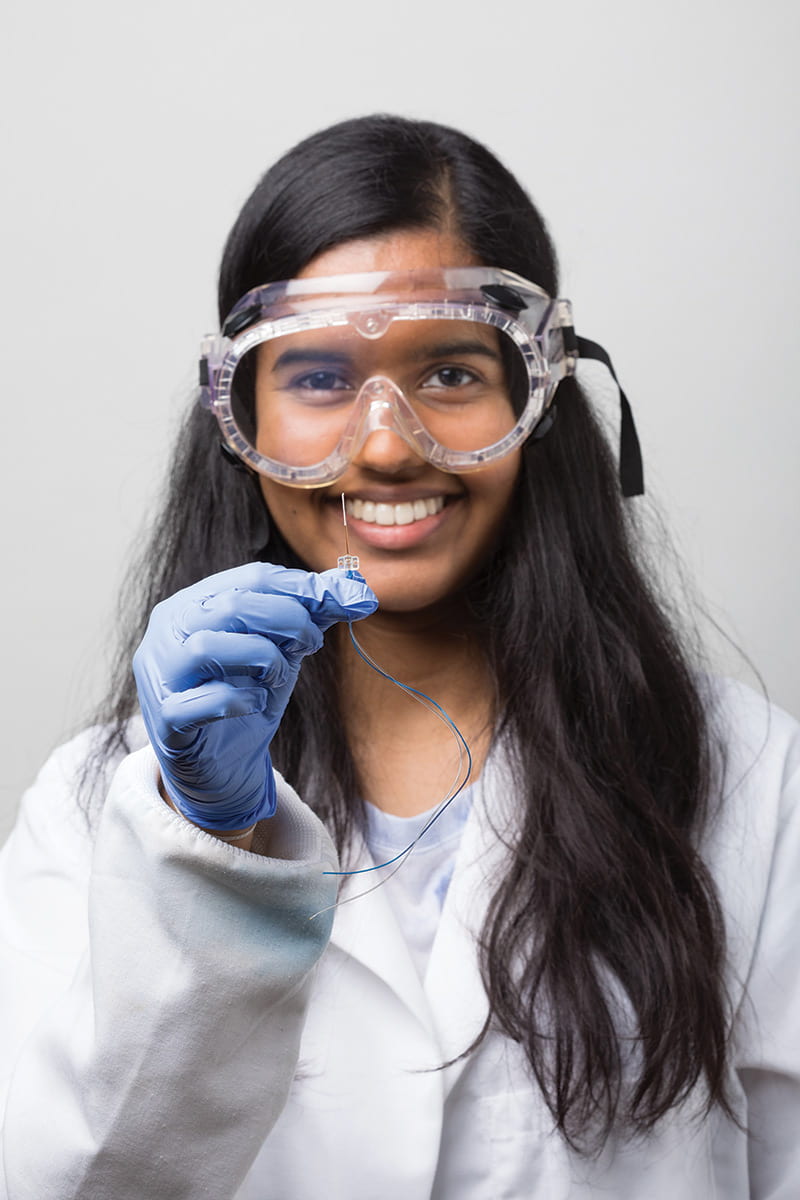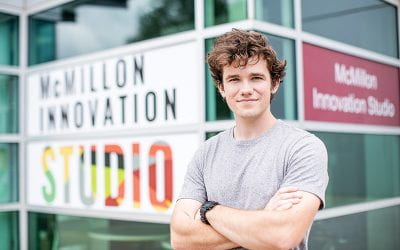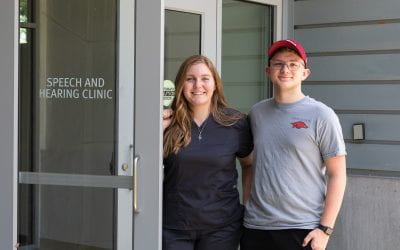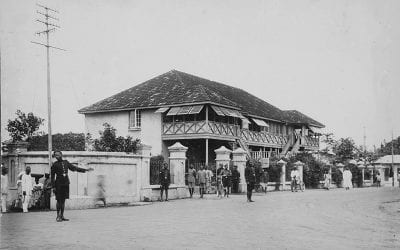Probing Pollution at Lake Keith
By Samantha Kirby
Photos courtesy of Russell Cothren and Chieko Hara
If you’ve ever traveled along Highway 112 to Northwest Arkansas National Airport, you’ve likely passed Lake Keith on your way through Cave Springs. But you can’t be faulted for not noticing: On the surface, it’s just another concrete-rimmed, algae-choked duck pond. Beneath the surface, it’s even less inviting: the former fish hatchery contains mysteriously high amounts of contaminants, particularly nitrogen.
No one knows for sure where the pollutants are coming from — they could be a result of rapid urbanization, or could be coming from the guano of bats living inside the cave at the site,” said honors chemistry and environmental science senior Srusti Maddala, whose honors thesis project was dedicated to finding a way to reduce the nitrogen levels in Lake Keith’s water. “But the ultimate goal for my project was to plant a riparian buffer zone along the southern bank of the lake to act as a natural filtration system.”
She is among the first researchers in the country to use microdialysis, a diffusion-based sampling technique, to measure nutrient fluxes in soil microsites. In particular, she tested for fluxes of nitrogen as it was absorbed by two commonly encountered plants, switchgrass and reed canary grass, to determine the plants’ ability to phytoremediate — that is, to remove nitrogen from their surroundings and sequester it in their own biomass.
To measure the nitrogen-retaining ability of these grasses, Maddala inserted tiny microdialysis probes into the plants’ rhizospheres — the areas surrounding their root systems. Because these probes are incredibly small and fragile, Maddala set up her experiment in a greenhouse rather than in the field. “The soil at Lake Keith is very rocky. I didn’t want to risk losing the probes and breaking them in that environment,” she explained.

“I hope that this research will lead to better sampling methods, so that we can better understand and manage soil ecosystems.”
She planted the grasses in soil extracted from the southern shore of Lake Keith and nourished them with the lake water to mimic the target environment as much as possible.
Maddala found that the switchgrass was much more effective at collecting and retaining nitrogen than the reed canary grass, which, to her surprise, had a very high flux in nitrate concentrations. “This means that despite existing nitrate in the water, even more nitrate was being produced in the root zone of the reed canary grass.”
“I think it would be really cool to study the microbial community, either through DNA sequencing or polymerase chain reactions, to learn more about what’s happening here. I’d also like to find a means to study how nutrient cycling is affected by these microbial communities and vice versa,” she added.
Maddala is attending the University of Arkansas for graduate school this fall and plans to delve deeper into this mystery for her master’s degree. “Looking back, I’m really grateful for this project, because it made me that much more prepared for grad school,” she said.
Maddala’s thesis is unique because it is heavily interdisciplinary, as evidenced by the fact that she had three mentors for the project: chemistry and biochemistry professor Julie Stenken; crop, soil and water sciences professor Mary Savin; and agriculture, food and life sciences professor Lisa Wood. Each professor is a specialist in certain aspects of Maddala’s research — but none in all. So Maddala oversaw her project in a very real sense, working to synthesize information in the gaps between three different academic specializations.
“The fact that I was in charge was intimidating at first. I could do what I deemed appropriate or necessary, and it was nice to have that kind of freedom, but there were times when things just didn’t make sense, and I just had to sit there and think through different solutions.”
This self-sufficiency was underscored by the sheer novelty of her methods: Microdialysis is a very new technique in field applications, and Maddala’s success suggests that it can be an effective, simple and noninvasive way to test soil samples in the field.
“Without using this system, you have to dig up soil, mix it with potassium chloride, shake it up, filter it — it’s very destructive, and requires significant periods of time from sampling to analysis. Which is a problem because soil is very dynamic,” she said. “If you take it and put it in an oven for a day, its contents are going to change. So, researchers think that this might not represent soil at its site of extraction.”
“If we don’t find a more precise and accurate way of understanding nutrient cycling in soil, it can just lead to more environmental deterioration,” Maddala warned. “Microdialysis provides a real-time, in situ means of nutrient sampling, which is a great alternative to extractions. So I hope that this research will lead to better sampling methods, so that we can better understand and manage soil ecosystems.”
Maddala’s research was supported by a SURF Grant, a Bumpers College Undergraduate Research and Creative Project Grant, and an Honors College Conference Travel Grant.
More Field Notes
Driving Innovation
Nick Foster, Lauren Horne, Colby Reed and Robbie Prettyman examine the prototype for a laser lighting system in the McMillon Innovation Studio.By Kendall CurleePhotos courtesy of Philip ThomasTruck drivers keep our economy moving and currently, they’re in short...
Band Aid
By Hiba TahirPhotos courtesy of Russell Cothren Emily Myers, a trumpet player in the Razorback Marching Band, looked around during a high school warm-up one day years ago to discover that — despite an alarmingly high decibel level that “maxed out” an app she used to...
Linking Fate + Future
By Katie Wilson PowellPhotos courtesy of Russell Cothren When it comes to politics, what impacts your opinions? When you fill out your race or ethnicity on the census, do you struggle with which box to check? These are key questions that Esmeralda Verdin Gomez...
Exploring National Identity By Design
By Brock DeMark Photos courtesy of Jim Tschetter/IC360 Images and Russell CothrenHonors architecture major Anna Ibru grew up in Lagos, Nigeria, in a neighborhood graced by many colonial-era bungalows on expansive lots. “My whole life revolved around buildings like...
Below: Maddala takes a water sample from the lake.





